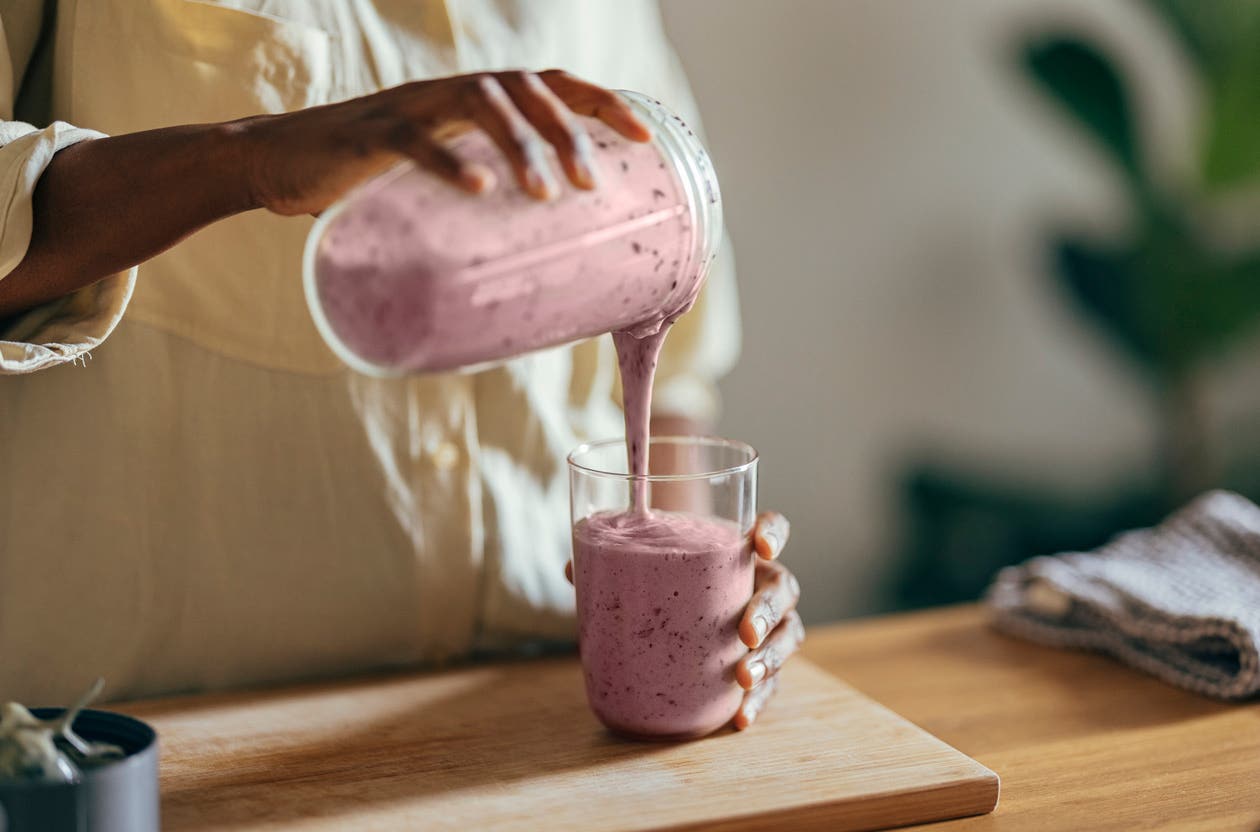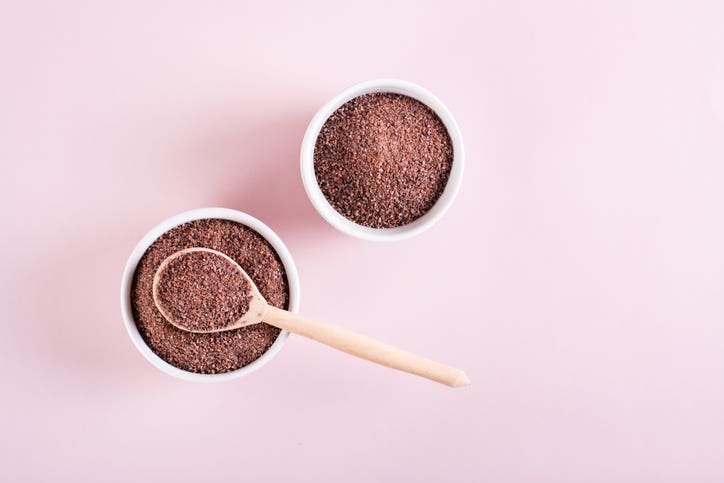
Are Smoothies a Nutritional Pitfall? Here’s What the Science Says
Smoothies have generated their share of controversy in recent years, with some people touting them as a convenient way to get more fruits and veggies into your diet, and others painting them as “sugar bombs” disguised as health food. Highly processed, juice-laden concoctions from the supermarket are a clear no-go—but what about smoothies made at home using only fruits and vegetables? Are they as good for you as the whole plant foods? To separate smoothie fact from fiction, we dove into the research and spoke with the experts. Here’s what we found.
Do Smoothies Cause Blood Sugar Spikes?
Fruits and veggies are high in natural sugars that, unlike refined sugar, come packaged with fiber and all sorts of other health-promoting nutrients. Fiber helps the body digest natural sugars at a healthy rate, avoiding steep spikes (and subsequent crashes) in blood glucose levels. That’s an important distinction because over time, repeated spikes in blood glucose can increase the likelihood of cardiovascular disease and insulin resistance.
Historically, one concern that some doctors and nutritionists have voiced around smoothies is that blending fruit might break down its fiber and change the way we digest it, leading to blood sugar spikes. A 1977 study seemed to bear out this concern, finding that consuming pureed apples caused sharper spikes in blood sugar than eating apple slices (but smaller spikes than drinking apple juice).
But more recent research paints a more complex picture. Some fruits, such as mango, have been found to have a similar effect on blood glucose whether eaten blended or whole. Other fruits actually produce a smaller blood sugar spike when blended. “Smoothies don't necessarily cause the hyperglycemic response that we used to think,” says whole-food, plant-based physician Thomas Campbell, M.D., co-author of The China Study. “It seems in some circumstances that the glycemic response is maybe even better.”
In 2020, a study published in the journal Nutrients looked at blood sugar levels in participants after consuming raspberries and passionfruit in whole and smoothie form and found that the smoothies caused lower blood sugar spikes relative to the whole fruits. A similar study in 2022 involving blackberries and apples found that an apple-berry smoothie produced a significantly lower glycemic response than the whole fruits. In both studies, the researchers suspected that the seeded fruits might be the key. “Grinding the seeds in blackberries during the blending process may have released additional fiber, polyphenols, fats, and protein that would not otherwise be released during [chewing] or normal digestive processes when the fruit is consumed in whole form,” the authors noted.
The Calorie-Density Factor
Despite the encouraging findings regarding smoothies and blood sugar, Matthew Lederman, M.D., co-author of The Forks Over Knives Plan, says that the recent research is “hardly a reason to start blending all your fruit.”
Pure fruits and vegetables, whether in blended or whole form, are both healthy, Lederman says. “But the main concern with smoothies is that drinking calories can lead to consuming more calories than if you were to chew whole fruit,” says Lederman. “Excess calories, not a minor glucose difference, are the bigger issue for most people.”
“Don’t drink your calories” is a common refrain in the whole-food, plant-based community, as a number of studies have found that consuming calories in liquid form, such as fruit juices, makes it easier to go overboard on calories. Research on smoothies, which fall somewhere between liquid and solid, is more sparse.
A 2009 study out of Penn State University had healthy adults consume an equal amount of calories via apple slices, applesauce, and apple juice before a meal to see how the different forms impacted mealtime calorie intake. They found that, after eating apple slices, participants tended to eat fewer calories during a meal than they did after eating applesauce. If they drank apple juice, even with added fiber, they ate as many calories at mealtime as they did when they had no snack or beverage beforehand.
In 2018, a study compared whole fruit versus smoothies when it comes to satiation—the feeling of fullness after a meal. As expected, participants reported feeling fuller after eating whole fruit than after drinking the smoothie equivalent. Yet, interestingly, participants did not end up consuming more calories after the smoothie than after the whole fruit. (The study was funded by a smoothie company, but the authors note that this did not influence their research.)
Barbara Rolls, Ph.D.,—author of Volumetrics and co-author of the Penn State study that compared apples, applesauce, and juice—says more research is needed to understand how blending fruits impacts satiation, but in general, taking more time to eat helps the brain register feelings of fullness.
“The chewing and the rate of eating are key—that, I think, is part of why we found the apple slices to reduce intake, to be more satiating than the applesauce or the beverages,” says Rolls. “Also, the perception of volume affects intake.”
“You might not feel as ‘full’ with smoothies [as with whole plant foods],” says Shilpa Ravella, M.D., gastroenterologist and author of A Silent Fire: The Story of Inflammation, Diet, and Disease. “But the difference isn't as marked as, say, if you eat refined junk foods versus whole foods.”
The Bottom Line
In a country where 9 in 10 adults aren’t eating enough fruits and vegetables, smoothies offer a healthful, easy way to up produce intake. “[Smoothies are] great for people who might not otherwise have time to sit down and chew the same amount of plant foods, or people who are looking for the convenience of being able to add a fair amount of leafy greens and other vegetables, berries, spices, etc., into one meal pretty easily,” says Ravella.
Lederman and Campbell recommend opting for whole plant foods as much as possible, having smoothies only occasionally, and making them at home, with whole plant food ingredients including leafy greens.
“The closer to the original form, the better,” says Rolls. “But on the other hand, if people won't eat [whole fruits and vegetables] in the original form, and they will eat [smoothies], then that's better” than not having fruits or vegetables at all.
To learn more about a whole-food, plant-based diet, visit our Plant-Based Primer. For meal-planning support, check out Forks Meal Planner, FOK’s easy weekly meal-planning tool to keep you on a healthy plant-based path.

About the Author

About the Author
Courtney Davison
Join our mailing list
Get free recipes and the latest info on living a happy, healthy plant-based lifestyle.
By providing your email address, you consent to receive newsletter emails from Forks Over Knives. We value your privacy and will keep your email address safe. You may unsubscribe from our emails at any time.